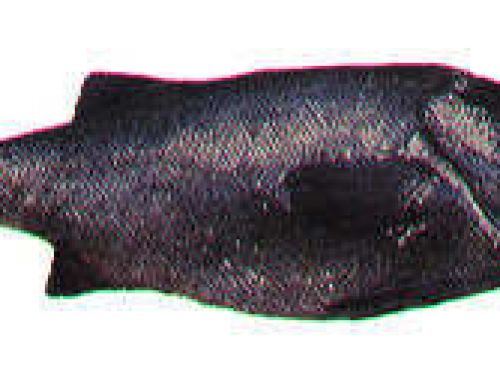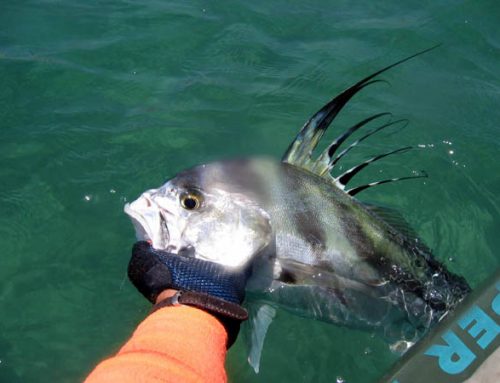The Baja peninsula offers several hundred miles of uninterrupted coastline, much of it punctuated by a seemingly endless number of protected coves, beaches and grottos. Although shore casting has always been the most commonly practiced method for taking fish in most of these remote areas, a new breed of highly adaptable fishing kayak now makes it possible to work the inshore zone for a much wider variety of species and enjoy a level of action that is virtually unattainable by those fishing from the beach or rocks just a few hundred yards away.
The portability factor of a fishing kayak is also a big advantage if you happen to be visiting a region that does not have a ramp, which might be needed to allow access by larger craft. Luckily, industry leaders such as Ocean Kayak, Cobra and Hobie now offer hard-body, sit-on-top kayaks that can be easily launched from just about any beach. They are perfectly designed for inshore fishing and are available at prices well under a thousand dollars.
Many surface fish, such as bonito and barracuda, prefer lures that move rapidly through the water, while others – like the highly prized white seabass – are more likely to inhale a live mackerel or artificial that is pulled a little deeper in the water column at a slower speed. One of the advantages of trolling from a kayak is having the ability to pull your bait much more slowly than is generally possible in a powerboat that is not equipped with a special trolling motor.
Often, you’ll catch more fish by simply finding a “fishy” looking area and sitting in a stationary position for a while. Try casting plastics, surface iron or Krocodile-style spoons toward the edge of kelp growths, or drop down a heavier jig with a frozen squid pinned to the end and bounce it along the rocky bottom. Some kayak anglers prefer catching their own live bait – usually small mackerel – to pull along behind them in a bait sled until it is needed.
No matter how you plan to fish after making the decision to purchase a kayak for ocean waters, it is vital to learn how to use it safely and effectively. The best way to do this is by taking the time and money to invest in a training course from any one of the several certified professionals in your area who provide such services. A few of them also offer guided kayak fishing trips to nearby local beaches, as well as to more secluded places where the average person might not choose to venture on his or her own.
As the sun peaks over the chaparral-covered hills at the end of the Punta Banda peninsula on northern Baja’s Pacific coast, the long strands of resident kelp inside La Bufadora’s placid cove often appear to create a shimmering sea of gold. To Dennis Spike, known simply as “Spike” to his friends and clients, this picturesque sanctuary has also become a perfect venue for gently introducing others to the glories of kayak fishing in a virtually unspoiled marine environment that lies less than 100 miles south of the Mexican border.
Spike was one of the original pioneers to popularize the sport of West Coast kayak angling. Several decades ago, he and his cousin started rigging up their own sit-on-top kayaks for fishing and immediately noticed that they began to consistently catch more and bigger fish than ever before.
During their first year of experimentation, they successfully fished hundreds of times in areas that had previously been accessed almost exclusively by powerboats. An added bonus came when they discovered their ability to fish extremely productive places in dense kelp and around boiler rocks that conventional craft were unable to reach safely.
In late 1994, Dennis Spike created the domain kayakfishing.com, and published his first magazine kayak fishing feature in February 1995. In 1997, www.kayakfishing.com became the first Web site dedicated to kayak fishing on the Internet, and is now accessed by thousands of visitors each day.
What was once Spike’s personal passion for the outdoors had inadvertently turned into a career change. In the course of helping to nurture and grow this newly popular sport, Coastal Kayak Fishing has also managed to become one of the foremost guiding and outfitting dealerships on the south coast.
I happened to drop in on Spike and one of his groups down at Rancho La Bufadora a few weeks ago as they prepared for an early-morning departure the next day. Although it was December and the nights were chilly, the irrepressible Baja sun broke through the clouds early that weekend, which helped to enhance the sensory impact of the golden kelp forest and turquoise waters churning around the jagged, volcanic outcroppings near shore.
Armed with numerous rods that were loaded with an assortment of deadly looking lures, and backpacks stuffed with hastily made sandwiches, potato chips and Buddy Bars, the group of fewer than a dozen departed. One by one, they slid out into the rising tide near La Bufadora’s crumbling cement launch ramp just below the cliffs. Watching them from the beach, I was reminded of an assemblage of ravenous seagulls; loosely organized on the hunt, but ready to strike in a simultaneous flurry once their prey was sighted. It became obvious that to a seasoned kayak angler, the sport is much more than a mere hobby; it becomes an adopted lifestyle.
On this particular voyage, the group managed to take a selection of bottom species, but also had to deal with large swells that occasionally called their attention to maintaining the stability of their boats instead of catching fish. The next day was better, however; as the water flattened out, the sun decided to shine a bit brighter and the fish were in a feeding frame of mind.
Over a period of a few days, their coolers began to fill up with fresh fillets. More important, by the time they were ready to head back toward the border on Sunday afternoon, they had also amassed volumes of happy memories to take with them. Memories to be pulled out and savored – perhaps one day in the middle of a bumper-to-bumper traffic jam on a crowded Southland freeway. Thoughts of a place where small kayaks and daring, determined anglers can quietly slip away from the beach in a placid lagoon to paddle off in pursuit of hungry fish.
Got a question, comment or a hot fishing tip? Share your input by sending an e-mail to: tlgatch@4dcomm.com.




